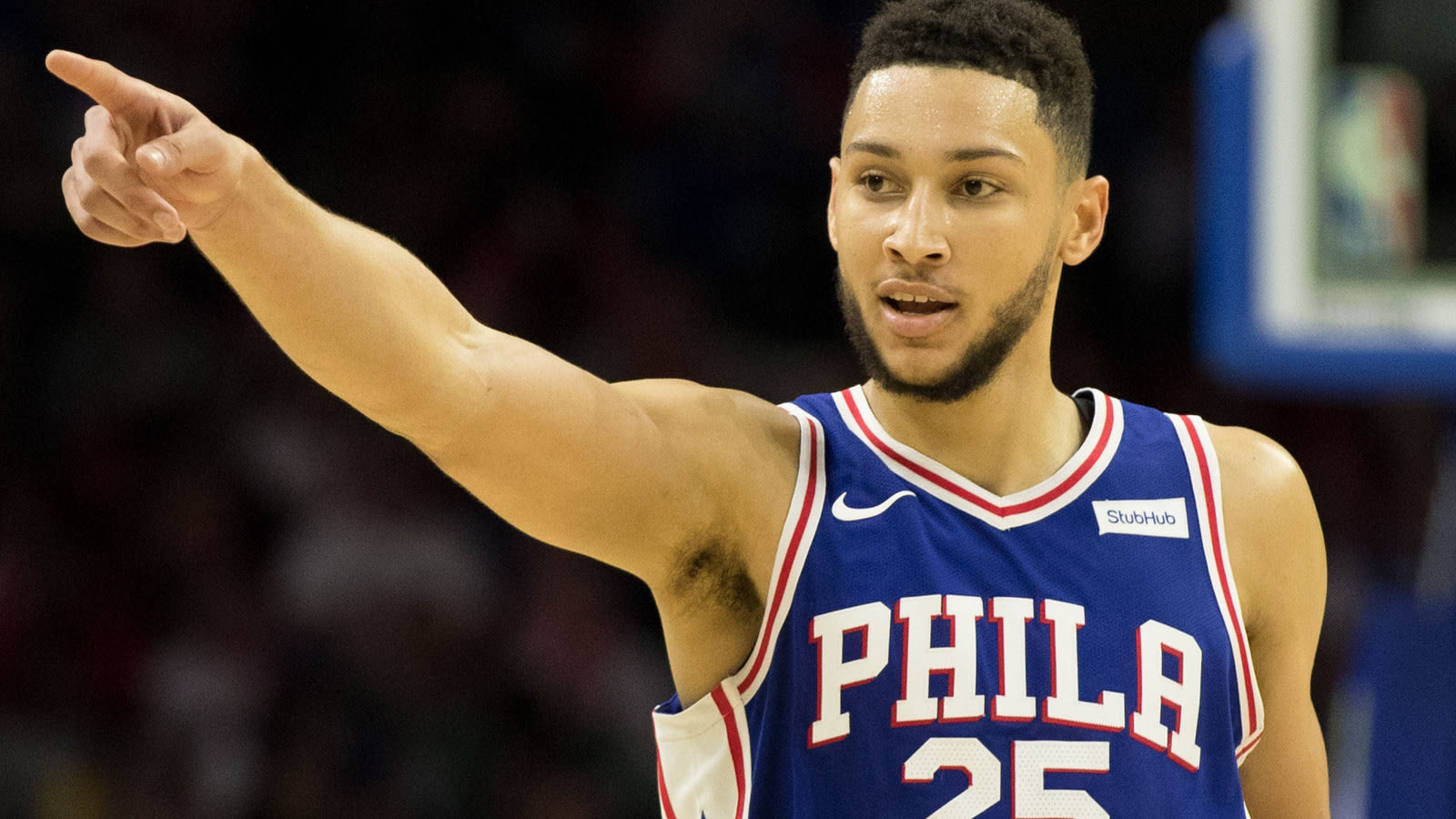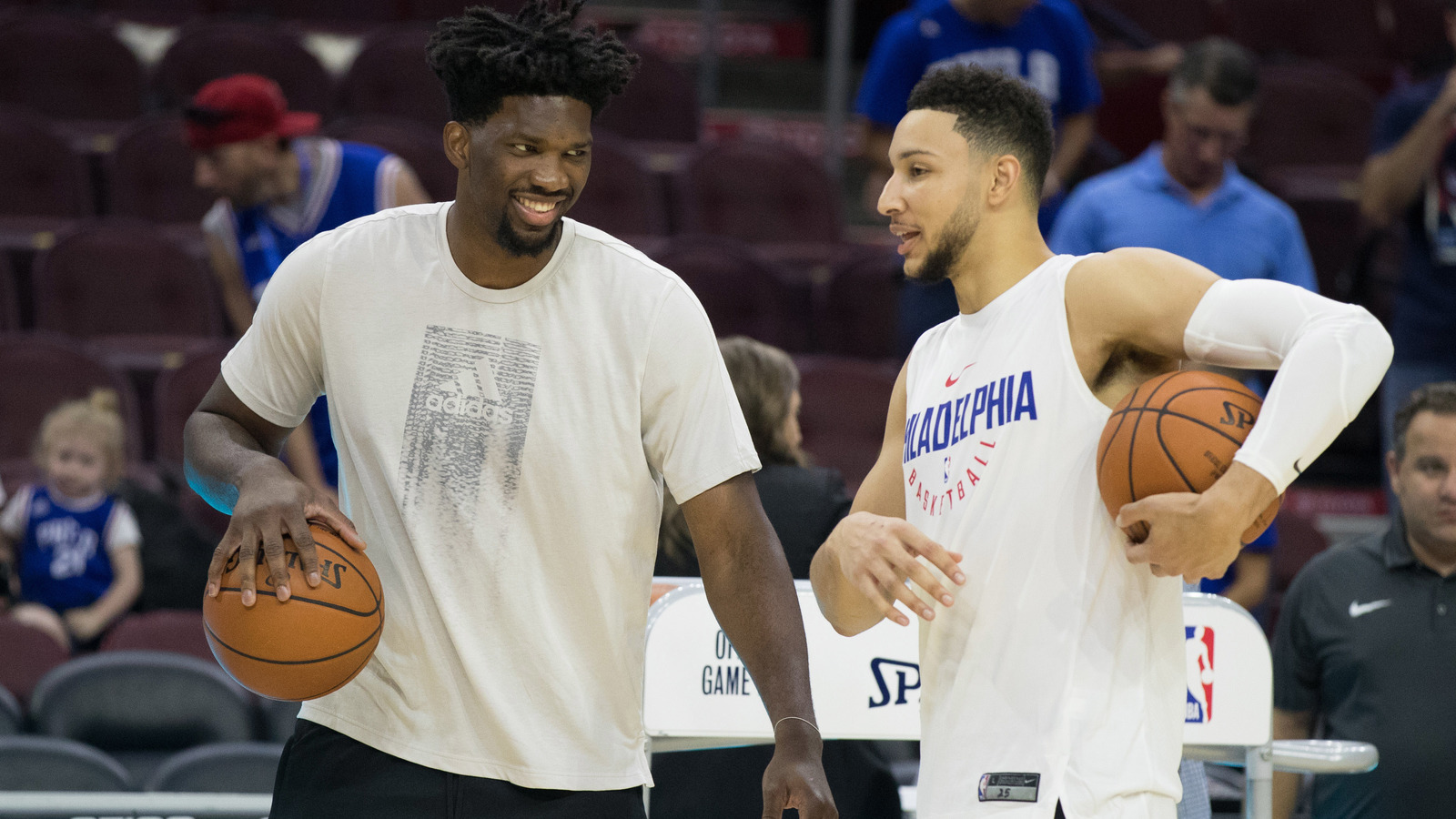
Follow Ben Simmons as he leads us to the NBA's unknown future
It's midway through the third quarter, and Ben Simmons is initiating a horns set against the Los Angeles Lakers. Joel Embiid and Dario Saric have met Simmons at the top of the perimeter to set the requisite screens with Simmons 40 feet away from the basket, surveying the whole floor. The 6-10 point guard crosses over from left to right to come off Embiid’s screen, head up and looking to aggressively attack the basket.
As Simmons begins to turn the corner, Embiid starts to roll off his left shoulder toward the middle of the paint. In this very moment, five sets of eyes are transfixed on watching the process unfold. Deep in the right corner stands a shooter in J.J. Redick, who has finished in the top 10 in 3-pointers made in each of the previous three seasons. Because of Simmons's propensity for getting to the rim and the tear Embiid has been on this night, Redick is so open that waiting for a kick-out pass to finish off a shot he’s hit 1,300 times in his career makes almost no sense.
Instead, he cuts to the basket, unnoticed, and receives a punctiliously placed pass with four defenders in arm's reach of Simmons, the distributor.
It wasn’t Simmons’s most memorable play of the night, but the attention he received off that screen is emblematic of the attention he’s receiving everywhere — and we should be willing to go anywhere he takes us.
We know Simmons is supposed to represent the essence of what we traditionally think a point guard is, but it’s hard to fully grasp when you see him blow by Lonzo Ball on the break, Euro-stepping at full speed from 15-feet out and throwing it down with both hands.
Ben Simmons continues where he left off with a slam!@Sixers are off to a fast start on ESPN. pic.twitter.com/QnI8xeDnlf— NBA (@NBA) November 16, 2017
One of the advantages Ball has over a number of his peers is his size and the vision he has as a direct result of that size. At 6-6, he’s a true point guard with the same height as Kobe Bryant. Watching the 6-10 Simmons tower over Ball combined with his speed and athleticism impels us to continually question what a point guard is, really. Watching him teeter on the edge of triple-doubles on a nightly basis, it becomes more evident that the evolution of basketball archetypes is nonlinear, and Simmons is just the latest young star to transcend positional limitations.
We’re a long ways from the protoplasts who brought Dr. James Naismith’s vision to life, but if there is anything that we should learn from watching Simmons it's that we’re far from the apex of individuality. Basketball can exist for another century before Michael Jordan is completely pushed off the throne reserved for the game’s greatest, but we might not have to wait another full calendar year before we see something, or rather someone, new again. The combination of kids naturally emulating their favorite players in driveways and public parks and the democratization of shared positional responsibility are opening doors for the kinds of players we could have only dreamed about existing 15 to 20 years ago.
Watching a 6-10 point guard get to the rim at will with sublime vision on the break is bigger than just watching a 6-10 point guard get to the rim at will with sublime vision on the break. It’s an unconventional way of thinking, but the NBA is in a better place when we’re clueless as to the direction the game is heading, and Simmons's incandescent play is playing a major role in keeping us in the dark. In a sense, The Process was essentially about imagination, and this 76ers team helps us think beyond the concrete realities of the past. With players like Simmons, adults are able to forsake structure and think of borderline impossible big-picture possibilities while kids chase myriad dreams that break the age-old punctilio of wanting to "Be Like Mike."
What’s most important about atypical players like Simmons is that it forces new kinds of conversations. Steph Curry’s innate shooting ability allowed us to watch the exploration of uncharted territories of the court. Giannis Antetokounmpo’s length is more of a utility instead of a tool while Russell Westbrook plays with an ethos of addition by destruction. With the despecialization of roles among today’s players, the hierarchy from the game’s elite to its worst is rendered meaningless, solely because of players as unique as Simmons. Today, watching the game should be less about who is the best at what they do, but more about the players who make us feel something beyond the spectacular.
It’s easy to get caught up in the comparison game so early in Simmons’s career. There are the obvious Magic Johnson parallels, the Lamar Odom comps and the idea that he’s an extension of the LeBronification of today’s stars. Simmons can be any of these players if you want him to be, but it takes away from whom we can imagine him becoming. Simmons, if anything else, helps enhance the legacy of those who came before. Magic, Lamar and LeBron all were players who were well ahead of their time. Their play likely helped contribute to who Simmons is in the present, but who he is tomorrow is entirely up to him (and up to us to interpret).

Our ability to adjust how we view Simmons over time is directly related to his personal growth and how he grows with this team — and it has to be this team. Brett Brown structures Philly’s style of play around his two young stars who play outside of the structured realities of what their positions traditionally represent. Where Odom was a forward with a point guard’s mind-set, Simmons is a point guard in a forward’s body, and watching him play off of and with Embiid feels familiar but unrepresentative of anything else the NBA has to offer right now.
Watching Embiid feed a cutting Simmons from the pinch on one possession and Simmons finding Embiid in heavy traffic on another is completely counter to the style of play most teams are trying to emulate in Golden State. Simmons has taken seven shots from beyond the 3-point line this season, and all seven of them have been half- to full-court heaves. The average distance on his 3-point attempts is 68.5 feet, and all of them have come at the end of quarters. His whole offensive tenor is a desire to get to the basket or feed teammates in better opportunities to score.
Teams have tried packing the paint to keep Simmons away from his strength, but he’s been surrounded by excellent shooting all year. Six Sixers are shooting at least 35 percent from deep on at least three attempts per night. Even without being a huge 3-point threat, Embiid’s ability to handle the ball on the perimeter has helped with the spacing Simmons needs to operate.
The 76ers will not compete for an NBA title this season, but they’ll likely make the postseason barring no (other) significant injuries — and they're doing all of this with the latest No. 1 overall draft pick sidelined with a shoulder injury. Philly’s roster has been built around the notion that, in order for the Sixers to have any kind of structure for their future, they have to have players who have no real positional structure at all. Simmons, Embiid and, to a lesser extent, Saric flow in and out of structural realities, and their inherent ability to do so is what makes them, and the direction of the league, so fascinating.
Embiid, if he can remain fully healthy, will absolutely change basketball forever. But it’s Simmons's uncanny ability to be both himself and everyone else that is going to move Philly from a culture of strategic losing to unstructured success. With the 76ers, we’re on a path heading in a direction no franchise has traveled before. It’s an exciting odyssey, and we all should be willing to go as far as Simmons will take us.
More must-reads:
- The Process has finally come to life for the 76ers
- Seven most impressive rookies of the NBA season so far
- The 'Highest career PPG in the playoffs' quiz
Breaking News
Customize Your Newsletter
 +
+
Get the latest news and rumors, customized to your favorite sports and teams. Emailed daily. Always free!


